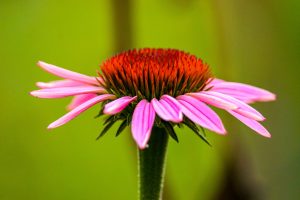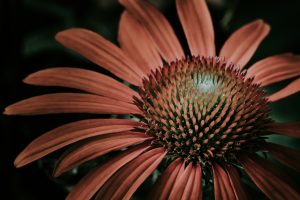
Echinacea is a common purple coneflower that goes mostly unnoticed, other than it’s a really pretty flower.
It’s a perennial, very easy to grow because it requires little water, and is a very hardy plant.
Echinacea is native to eastern North America, it grows in the wild, and was used in traditional herbal remedies by the Great Plains Indian tribes.
Today, Echinacea is widely used to fight infections, especially the common cold, and the flu.
Some Health Benefits

The roots and the leaves of the plant are what have been traditionally used for medicine.
Echinacea is used for:
- resisting a cold or the flu;
- controlling blood sugar;
- aiding in healthy cell growth, which helps repair wounds;
- managing anxiety;
- treating migraines and pain;
- lowering blood pressure;
- reducing inflammation; here’s wound healing again;
- reducing breast cancer formation.

How Much And For How Long?
As with basil or oregano, or any natural herb, there is no standard dose of echinacea. Some people drink echinacea tea, and there’s no standard dose for that, really.
One point that I stress when taking any herb is to take them only when needed and when health symptoms first appear. I do not recommend taking any medicinal herb for longer than 10 to 14 days in a row.
Why?
Herbs are powerful and some can be quite potent. As with any drug, your body should only use them for immune support without dependence. After initial nutritional assistance has been provided, you need to let your immune system take over on its own.
Echinacea is the most effective when it is started as soon as health symptoms are noticed; it can be taken many times a day, but used for only 10 to 14 days.
Take a break when using any medicinal herb – stop taking it and give your body a break for 10 to 14 days, and then resume taking it for another 10 to 14 days, if needed.
It’s an off and on thing.
Side Effects

Echinacea can have side-effects, especially if you have been using too much for too long at one time.
Some side effects:
- upset stomach/nausea
- vertigo/dizziness
- rashes
- swelling
- asthma symptoms/difficulty breathing
It never hurts to plant some in your garden. Especially during cold and flu season.
_____________
If you want to learn more about healthy supplements, contact me at janethull.com. Remember that you are never alone when you are looking for good health!
Gain access to all of my online programs, ongoing support, monthly Q&A, and more by joining my Private Inner Circle Membership Program. I look forward to supporting you on your journey to alternative health and wellness.
_____________
Disclaimer: This article is for informational purposes only, and is educational in nature. The FDA may not have evaluated some of the statements. This article is not intended to diagnose, treat, cure, or prevent any disease. Please discuss with your own, qualified health care provider before adding supplements or making any changes to your dietary program.
Before taking vitamins, consult your doctor; pre-existing medical conditions or medications you are taking can affect how your body responds to multivitamins.
You have our permission to reprint this article if you attribute us with a live back-link to this article and the youtube links. https://janethull.com/